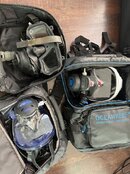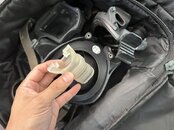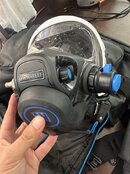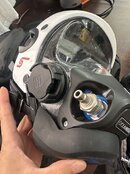seals9121
Registered
Long story short, I have extensively researched and read articles and reviews about Kirby Morgan, OTS, and Ocean Reef Full Face Masks (FFMs). However, the best way to determine the most suitable FFM is to try them out firsthand.
Over the past three years, I have personally used OTS, Ocean Reef, and Kirby Morgan FFMs, with the recent addition of the Neptune 3. I want to share my experiences after approximately 100 to 150 dives with these masks. I apologize if my straightforward approach upsets you, especially if I express a negative opinion about a product you own.
Background: I frequently dive in cold waters below 30 meters in California, specifically Los Angeles. My diving depth typically ranges from 30 to 40 meters, as there is an abundance of fish, clams, and other marine life, especially around the oil rig areas.
During my dives, I carry various equipment, including a Sony A7RIII camera with an underwater casing, a single light, a 55 spear gun, and game bags. With 133 tanks, I stay underwater for extended periods, so the comfort and ease of use provided by the FFM are crucial to me. I engage in recreational diving and occasional tech dives for fun, without any involvement in commercial diving.
Therefore, please note that my experiences with these products may be specific to my use case. Now, let's delve into my thoughts on each FFM:
OTS FFM: I find the OTS FFM to be similar to the Ocean Reef FFM, but Ocean Reef surpasses it in every aspect. If you are not on a tight budget and seeking a used FFM, there is no point in opting for the OTS FFM. I ended up giving mine away for free after purchasing the Ocean Reef FFM. Additionally, the communication system of the OTS FFM is cumbersome to use, and you can look up what others have said about it.
Kirby Morgan M48 Mod-0: This FFM is quite challenging to acquire, with little to no support from dive stores. I bought it mainly because I saw it in numerous YouTube videos and found it visually appealing. It turns out I was correct; it does look cool, especially when I used it in the kitchen connected to my air tank (I'm not kidding, I actually did it). But let's get back to the main topic.
The good thing about the Kirby Morgan M48 Mod-0 is that it can be used with closed-circuit rebreathers (CCR), such as the JJ CCR. You can change the pod to suit different diving situations. However, for recreational use, it is not a suitable option. Firstly, you still have to put the mouthpiece in your mouth, which defeats the purpose of a full-face mask. Secondly, obtaining the communication system and other accessories from Kirby Morgan takes time, and they are expensive. Therefore, I do not recommend this system for recreational divers as it is overly complicated for a regular dive trip. Personally, I love the mask and its cool appearance, but it has been sitting on the shelf unused for about a year now.
Ocean Reef FFM: In my opinion, this is the best FFM system I have used thus far. I purchased it at full price and believe I was one of the first to import it from Europe to the US. I love it. Most dive stores, particularly Scuba City in Los Angeles, can readily provide parts for it. The FFM comes in three different sizes, offering excellent comfort and ease of use. The most important feature for me is the reliable communication system. On one occasion, when my dive buddy went missing, I was able to quickly locate them around 30 meters away in the murky waters of California. If you are familiar with these conditions, you know they are far from clear; they can be quite unpleasant. With the Ocean Reef FFM, you can breathe through your mouth and nose, and a slight push allows you to balance the ear pressure. After adding the quick disconnect to the FFM, it simply works flawlessly. I carry it on every dive trip. I haven't used second stages for two years, and I keep a backup mask in my drysuit pocket, which I have never needed to use, and hopefully never will. The FFM is also positively pressurized, so even if there is a gap between the mask and your face, such as hair getting in the seal, there will be no water leakage. You can easily feel the bubbles coming out from the FFM.
In my opinion, for recreational diving, the second stage is obsolete. None of my friends who have purchased FFMs have gone back to regular second stage mouthpieces. Speaking and communicating underwater is the way to go. Of course, it is essential to learn the basics, but there is no reason to still use a mouthpiece. It simply does not feel natural. Perhaps I am on the extreme side when it comes to adopting new technology—I've always been a fan of new tech. However, based on my experiences over the past three years, including some simple tech dives, I now simply switch tanks using the Ocean Reef valve. I no longer want to remove my FFM in the cold waters of California. Drysuits and FFMs are the way to go.
Over the past three years, I have personally used OTS, Ocean Reef, and Kirby Morgan FFMs, with the recent addition of the Neptune 3. I want to share my experiences after approximately 100 to 150 dives with these masks. I apologize if my straightforward approach upsets you, especially if I express a negative opinion about a product you own.
Background: I frequently dive in cold waters below 30 meters in California, specifically Los Angeles. My diving depth typically ranges from 30 to 40 meters, as there is an abundance of fish, clams, and other marine life, especially around the oil rig areas.
During my dives, I carry various equipment, including a Sony A7RIII camera with an underwater casing, a single light, a 55 spear gun, and game bags. With 133 tanks, I stay underwater for extended periods, so the comfort and ease of use provided by the FFM are crucial to me. I engage in recreational diving and occasional tech dives for fun, without any involvement in commercial diving.
Therefore, please note that my experiences with these products may be specific to my use case. Now, let's delve into my thoughts on each FFM:
OTS FFM: I find the OTS FFM to be similar to the Ocean Reef FFM, but Ocean Reef surpasses it in every aspect. If you are not on a tight budget and seeking a used FFM, there is no point in opting for the OTS FFM. I ended up giving mine away for free after purchasing the Ocean Reef FFM. Additionally, the communication system of the OTS FFM is cumbersome to use, and you can look up what others have said about it.
Kirby Morgan M48 Mod-0: This FFM is quite challenging to acquire, with little to no support from dive stores. I bought it mainly because I saw it in numerous YouTube videos and found it visually appealing. It turns out I was correct; it does look cool, especially when I used it in the kitchen connected to my air tank (I'm not kidding, I actually did it). But let's get back to the main topic.
The good thing about the Kirby Morgan M48 Mod-0 is that it can be used with closed-circuit rebreathers (CCR), such as the JJ CCR. You can change the pod to suit different diving situations. However, for recreational use, it is not a suitable option. Firstly, you still have to put the mouthpiece in your mouth, which defeats the purpose of a full-face mask. Secondly, obtaining the communication system and other accessories from Kirby Morgan takes time, and they are expensive. Therefore, I do not recommend this system for recreational divers as it is overly complicated for a regular dive trip. Personally, I love the mask and its cool appearance, but it has been sitting on the shelf unused for about a year now.
Ocean Reef FFM: In my opinion, this is the best FFM system I have used thus far. I purchased it at full price and believe I was one of the first to import it from Europe to the US. I love it. Most dive stores, particularly Scuba City in Los Angeles, can readily provide parts for it. The FFM comes in three different sizes, offering excellent comfort and ease of use. The most important feature for me is the reliable communication system. On one occasion, when my dive buddy went missing, I was able to quickly locate them around 30 meters away in the murky waters of California. If you are familiar with these conditions, you know they are far from clear; they can be quite unpleasant. With the Ocean Reef FFM, you can breathe through your mouth and nose, and a slight push allows you to balance the ear pressure. After adding the quick disconnect to the FFM, it simply works flawlessly. I carry it on every dive trip. I haven't used second stages for two years, and I keep a backup mask in my drysuit pocket, which I have never needed to use, and hopefully never will. The FFM is also positively pressurized, so even if there is a gap between the mask and your face, such as hair getting in the seal, there will be no water leakage. You can easily feel the bubbles coming out from the FFM.
In my opinion, for recreational diving, the second stage is obsolete. None of my friends who have purchased FFMs have gone back to regular second stage mouthpieces. Speaking and communicating underwater is the way to go. Of course, it is essential to learn the basics, but there is no reason to still use a mouthpiece. It simply does not feel natural. Perhaps I am on the extreme side when it comes to adopting new technology—I've always been a fan of new tech. However, based on my experiences over the past three years, including some simple tech dives, I now simply switch tanks using the Ocean Reef valve. I no longer want to remove my FFM in the cold waters of California. Drysuits and FFMs are the way to go.








